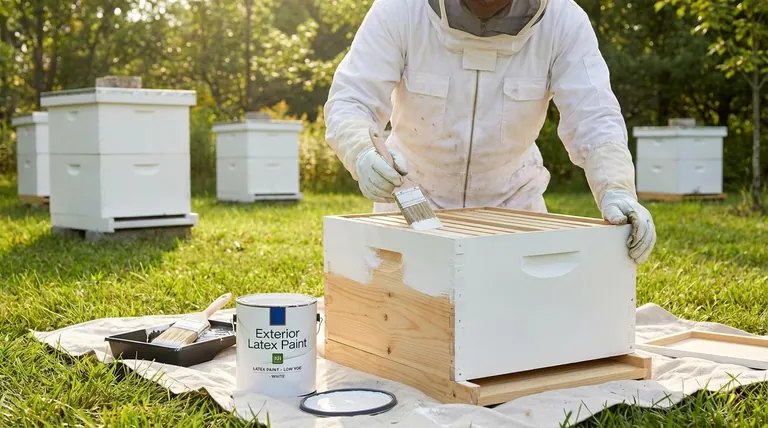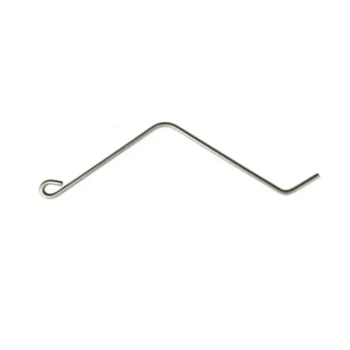For protecting your beehives, the standard recommendation is a high-quality exterior latex paint. This choice is overwhelmingly popular because it provides a durable, weather-resistant barrier for the wood while being fundamentally safer for the bees due to its water-based, low-toxicity formulation. Its widespread availability and ease of cleanup make it the most practical and reliable option for beekeepers.
The core decision rests on balancing two critical needs: protecting the wooden hive from moisture and sun, and ensuring the health of the colony inside. Water-based latex paint excels because it allows the wood to "breathe," preventing rot, while modern formulas contain minimal harmful chemicals (VOCs) that could harm the bees.

Why Water-Based Latex is the Standard Choice
Understanding the properties of latex paint reveals why it has become the default for beehive maintenance. It’s not just about convenience; it’s about creating a healthy, stable environment for the colony.
The Critical Role of Breathability
Wood naturally absorbs and releases moisture. Exterior latex paint forms a protective film that is permeable, allowing water vapor to escape from the wood.
This "breathability" is crucial for preventing moisture from getting trapped within the wood, which can lead to rot and decay from the inside out and compromise the hive's structural integrity.
Low VOCs for Bee Safety
Modern latex paints are formulated to have low or zero Volatile Organic Compounds (VOCs). These are the chemical solvents that off-gas as paint dries and can be harmful to living organisms.
By choosing a low-VOC paint, you minimize the risk of introducing toxic fumes into the bees' environment, ensuring their health is not compromised.
Durability Against the Elements
A hive is exposed to sun, rain, and snow year-round. Exterior-grade latex paint is specifically designed with binders that resist UV degradation and temperature fluctuations.
This durable coating significantly extends the life of your woodenware, protecting your investment and reducing the need for frequent replacements.
Practicality for the Beekeeper
Beyond its technical benefits, latex paint is a practical choice. It is affordable, available at any hardware store, and cleans up easily with just soap and water. This accessibility makes hive maintenance straightforward and efficient.
Common Pitfalls and Best Practices
While latex paint is the right choice, its application requires attention to detail. A few common mistakes can undermine the benefits or even harm your bees.
Interior vs. Exterior: A Crucial Distinction
You should only paint the exterior surfaces of your beehives. The bees manage the interior environment themselves by coating it with propolis, a natural antimicrobial resin.
Painting the inside of a hive can trap moisture, leading to mold, and the paint itself can chip and contaminate the honey and wax.
The Importance of Curing Time
Paint that is dry to the touch is not fully cured. The curing process is when all the remaining solvents evaporate, and the paint film hardens to its maximum durability.
You must allow the paint to cure completely for several days (or as directed by the manufacturer) in a well-ventilated area before introducing bees. This ensures all potentially harmful off-gassing is finished.
Choosing the Right Color
The color of your hive matters for thermoregulation. White or light pastel colors are the standard because they reflect sunlight.
This helps keep the hive cooler during hot summer months, reducing stress on the colony and allowing them to focus their energy on foraging and brood-rearing rather than cooling efforts. Dark colors absorb heat and should be avoided.
How to Apply This to Your Hive
Your specific approach may vary slightly depending on your primary goal.
- If your primary focus is maximum bee safety: Choose a zero-VOC, light-colored exterior latex paint and allow it to cure for at least one week before use.
- If your primary focus is longevity and durability: Apply one coat of exterior primer followed by two coats of high-quality exterior latex paint, paying close attention to the joints and end grain where moisture is most likely to penetrate.
- If your primary focus is convenience and budget: A good quality, all-in-one "paint and primer" exterior latex is an effective and efficient choice that provides reliable protection.
Properly painting your hives is a simple investment that pays dividends in both the health of your bees and the lifespan of your equipment.
Summary Table:
| Feature | Benefit for Beehives |
|---|---|
| Breathability | Allows moisture vapor to escape, preventing wood rot. |
| Low/Zero VOCs | Minimizes harmful fumes, ensuring bee colony health. |
| Durability | Protects against sun, rain, and snow to extend hive life. |
| Practicality | Easy to find, apply, and clean up with soap and water. |
Protect your investment and ensure your bees' health with the right supplies. HONESTBEE supplies commercial apiaries and beekeeping equipment distributors with high-quality, durable beekeeping supplies and equipment through our wholesale-focused operations. Let us help you build and maintain thriving, productive hives. Contact our expert team today to discuss your wholesale needs!
Visual Guide

Related Products
- Professional Plastic Queen Excluder for Modern Beekeeping
- Beehive Entrance Reducer Guardian Metal Hive Entrance for Bees
- Heavy-Duty Galvanized Steel W-Style Pallet Clip
- Professional Engraved Round Hive Number Tags for Beekeeping
- HONESTBEE Wooden Bee Escape Board with Triangle Mesh Design for Beekeeping
People Also Ask
- How does a queen excluder work? Master Hive Management for Pure Honey Harvests
- What are the pros of using a queen excluder? Boost Hive Control & Honey Quality
- Why are queen excluders recommended for Flow Hives? Prevent Brood Damage for a Clean Harvest
- What is the primary function of a queen excluder in beekeeping? Control Hive Layout for Efficient Honey Harvesting
- What are the main advantages of using a queen excluder in beekeeping? Simplify Hive Management & Harvest



















